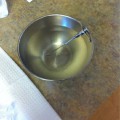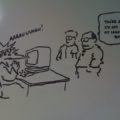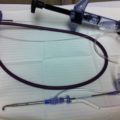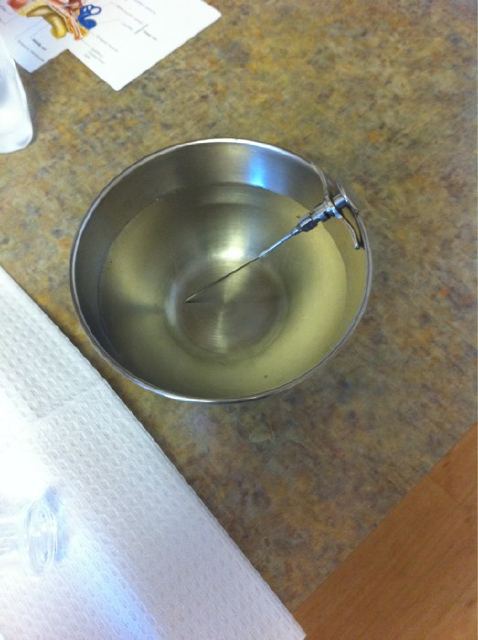…for those who are terribly concerned about the state of my head. 😉
Thanks to all who wrote or called with support and encouragement. Though I’ve had in-person support when it counted most through this ordeal, I have spent a lot of time alone in my apartment, not feeling well enough to go out for company or anything else. So “virtual” company has been more important than ever.
When we last saw our heroine (me), I was awaiting the results of another culture on the gunk in my sinuses. Pseudomonas did not show up on this one, which could mean that they simply didn’t catch it (or anything else) this time around, or that we’d finally got rid of the pseudomonas but I now had some other infection, possibly with anaerobic bacteria (which are difficult to culture). I certainly still had sinus infection symptoms (pressure, pain, fatigue). Anaerobic bacteria are easy to treat, at least, so the doctor switched me to augmentin, a milder antibiotic than the cipro I’d been taking again (with more nasty side effects) for the pseudomonas. If this worked, I might even avoid surgery.
In the meantime, I was trying to keep up a full workload including Oracle OpenWorld, my employer’s huge annual conference, which had taken over San Francisco. I managed to accomplish the tasks that no one else could do in my place: filming unconference sessions about various Solaris technologies. But it was physically punishing, especially as these were taking place about a mile from my home and I had little choice but to haul myself and equipment over there on foot. Having a full-blown migraine (which I very rarely get) on one of those days (all 24 hours) did not help.
This was followed by more, if slightly less severe, headaches which didn’t seem to be in the right place to be caused by sinus pressure. Dr. Johnson sent me for an MRI “just to make sure we’ll be cutting in the right place.”
That was a new experience. The first step was about 12 minutes of “just” imaging. If you haven’t done an MRI before, it’s like being stuck inside a car alarm: you’re in a tube with  very loud electronic noises whirling around you. Then the technician slid me out of the tube and stuck an IV into my arm to put the contrast solution – gadolinium – into me. I felt the “pinch” of the needle (why do they all call it a pinch? do they think I’ll be offended if they use the correct term, a prick?) but not much else, and he kept asking if I felt it burning going in. Nope.
He slid my head back into the machine and started it up again. Then my arm started to hurt like a sonofabitch – oh, yes, that burned. And I wasn’t supposed to move my head at all, so I couldn’t yell or swear. At some point during the three minutes of contrast imaging I was thinking: “I would rather just go ahead and die than go through any more painful procedures.” Okay, I’m a drama queen. But it really did hurt.
I later asked my friend John, who unfortunately has had a lot of experience with MRIs lately, and he confirmed that what I was feeling was the pull of the machine’s magnets on the metal in my veins. I was lucky to feel it only in my arm, and lucky that the contrast imaging didn’t take long.
The worst part was the anxious several days’ wait for results, but, as expected, these showed that there is nothing wrong (structurally, anyway) with my brain.
Meanwhile, the augmentin wasn’t doing much: the infection felt at least as bad as before, and grew steadily worse with more pressure and pain in my jaws, upper teeth, and ear, and more severe headaches (which were likely caused in part by stress).
The following week I agreed with my boss that it was time to go on medical leave. Illness is not made any easier by having to deal with scary and confusing bureaucracy, but I think we’ve finally go that sorted and, so far at least, I still have a job and a paycheck. Though the official corporate paperwork that came in the mail was careful to state that my job was guaranteed “unless your position is eliminated or there is a reduction in force.” Nothing like fear of losing your employment to aid the healing process…
I had the sinus surgery (endoscopic maxillary antrostomy) on October 7th. Normally this would be a minor procedure, but Dr. Johnson recommended that, because I was starting from a baseline of so much illness and trauma, I should take two weeks’ leave afterwards to recover. I can see now that he had a point.
I spent the night before the surgery imagining every possible worst-case scenario. It was done under general anesthesia which, as the anesthesiologist explained, differed from what I had last time only in the amount of the medication he gave me – it was the same stuff, and I hadn’t had any problems with it before, so nothing to worry about.
I remember walking to and lying down on the table in the (very cold) operating room and being bundled up with blankets and pressure pads around my legs. Next thing I knew, I was in the post-op recovery room with faces around me, but it took some time to coordinate my head and mouth to speak.
General anesthesia was different in ways I didn’t know to anticipate. It took me longer to clear my head and feel fully alert (then they put painkillers into me through the IV, so I don’t know where one effect left off and the next began). I remember people talking to me during that post-op recovery period (however long it was), but don’t remember everything that was said, and apparently I was already talking before I remember being conscious. Fortunately, I had a witness there to remind me later about the important stuff that was said to me.
I do remember Dr. Johnson saying that they found fungus inside my sinuses this time around – gross! But not unexpected when I’d been on antibiotics for so long; it’s only a wonder that I haven’t had a yeast infection yet. They’re culturing again to try to figure out what else may still be in my nose.
I guess under general anesthesia they have to intubate you, but I didn’t know about it coming or going, and had to infer it from the soreness in the roof of my mouth and my throat later on. My throat was particularly sore the next day, but this appears to be a common after-effect of surgery.
As for the procedure, there’s at least one video on YouTube, but for the moment I can’t watch it. It involves enlarging or re-opening the natural holes between the sinuses and the nose. This was done with an endoscope inserted through the nostrils, so no cutting through my mouth or face (the old-fashioned method, which I’m glad I missed out on). Still, there was cutting, and there are raw surfaces still bleeding in there. I guess in that dank, moist environment it’s harder for wounds to dry and heal. Blood only actually dripped out of my nose for a few hours after the surgery, but it’s still bleeding inside so I’m coughing and snorting it out from time to time – gently.
Once the openings were made, Dr. Johnson irrigated and flushed out the sinuses. I’m glad I was asleep through that this time.
I went home, had one strong painkiller in the evening after the IV stuff wore off, and then managed not to take any more pain medication for four days – a huge improvement. Â I’ve probably been avoiding medication more than I should, as I’ve still got quite a lot of pain and, from that, fatigue. Clearly recovery will take some time yet – I tire extremely quickly.
Saw Dr. Johnson for a post-op visit yesterday, and we’re still in wait-and-see mode. The cultures haven’t shown anything, but it may still be growing. I’m off all antibiotics for the moment; it may be that the gunk left in there by the time I got to surgery was old, dead stuff that had already been killed by the antibiotics but couldn’t get out of my poor, battered nose.
Perhaps my biggest problem at the moment is boredom; I’m very sick of being cooped up in my apartment, spending way too much time alone in my own head. However, I don’t have energy to do much and, being on medical leave, I’m probably not supposed to be out having fun anyway. Dr. Johnson did say after the surgery: “I’d tell you to take it easy, but I know that’s not in your nature.” Well, my body is telling me – in no uncertain terms – that this is a time when I must take it easy. So, more or less, I am.





